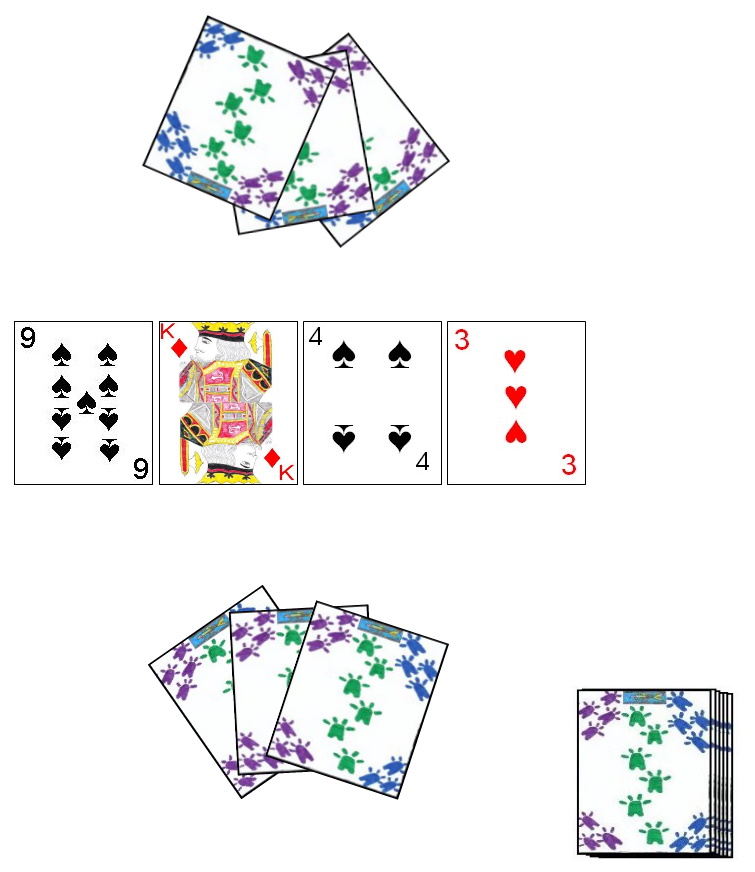 |
| An example of the initial layout and deal in the card game Snitch'ems. |
Determination of first dealer can be performed using a variety of methods, with a draw for high card the most commonly used. Each player would thus draw one card from the face-down shuffled deck, and the player drawing the highest card would be set as the first dealer (and have first choice of seats at the table). After each hand the role of dealer should alternate amongst the two players.
Once the first dealer has been determined, and the deck has been thoroughly shuffled and cut, he begins dealing the cards. He first deals three face-down cards to his opponent and then three face-down cards to himself. He then deals four cards face-up to the center of the table to form the center layout. He places the remainder of the currently unused deck to the side, to be used after the players have depleted each three card hand.
The opponent of the dealer has the first turn and the turn then alternates amongst the two players. The object of the game is to be the player who has managed to capture the most total cards.
Each turn consists of a player playing one card remaining in his hand to the table. In certain cases this play may allow a capture of a card or cards from the table. The following are the legal methods of capturing cards from the center layout:
- If the card played matches one or more other cards, also of the exact same rank, the played card and all other cards of that same rank can be captured. Capturing one card in addition to the played card is called a pair, and capturing two or three such cards is called a pair royal (also called a prial).
- If the card played, added together with one or more other cards on the table can create a sum of exactly eight, all cards involved in reaching that exact sum can be captured.
- If the card played, added together with one or more cards already on the table create a sum of exactly ten, all cards involved in reaching that sum can be captured.
- In creating a sum of 8,using the card played and one or more cards already on the table, as described above, if there are also one or more cards of exactly rank 8 on the table, these cards can also be captured during the play.
- In playing a card to create a sum of 10, as described above, if there are also any cards of exactly rank 10 on the table, these cards can also be captured during the play.
 |
| In this example the Ace played to the table creates a sum of 10 as combined with the three, five and Ace already found on the layout. In addition, this play allows the capture of the ten also found on the table. |
For purposes of summing to eight or ten, most cards have a capture value. The number cards have a capture value equal to the number as marked on the card and an Ace has a capture value of one. Jacks, Queens, and Kings have no equivalent capture value and can only be captured through play of another matching card (i.e. a King can capture one or more other Kings already found on the table).
All captured cards are added to a capture pile maintained by that player throughout the hand. The card played should remain on the table sufficiently long for the opponent to verify the capture is a legal play.
After the initially dealt three cards have all been played by both players, the dealer then deals three more face-down cards to the players, and play continues as before. This continues over multiple deals until the deck has become exhausted. After these last three cards have been dealt and played, the hand ends. The last player to have made any capture from the table is entitled to take any remaining cards found in the center layout and add these cards to his capture pile. After this occurs, both players count the total number of cards captured during the hand, and the player who managed to capture the most total cards is declared the winner. If both players have captured the same number of cards (26), the game ends in a draw.